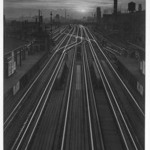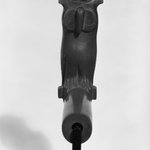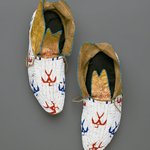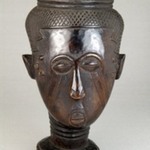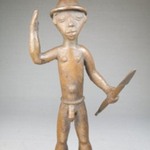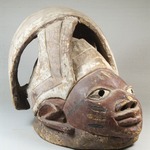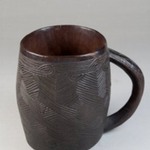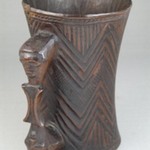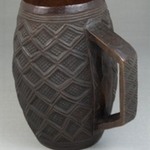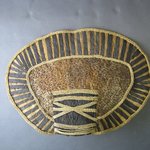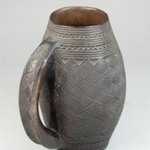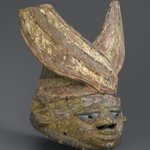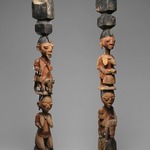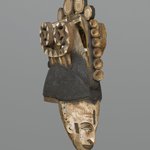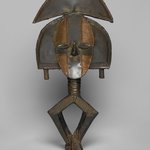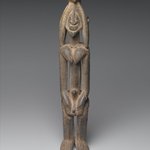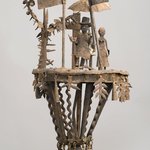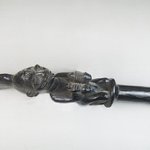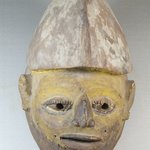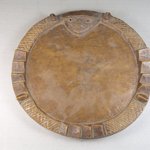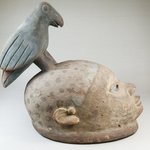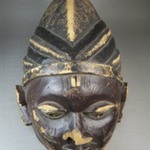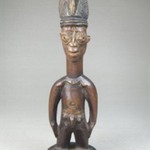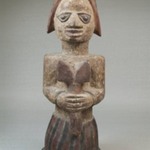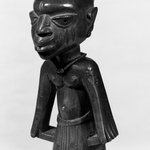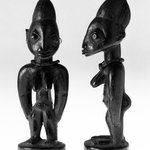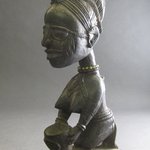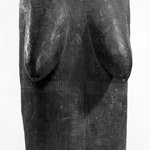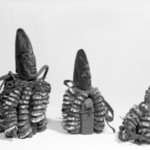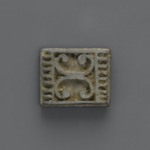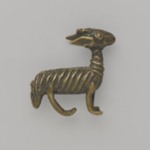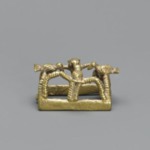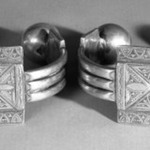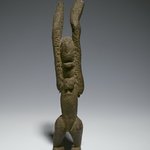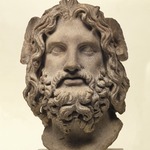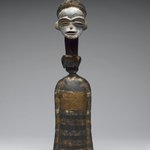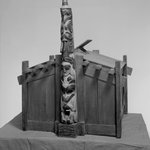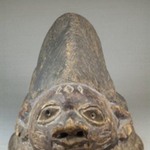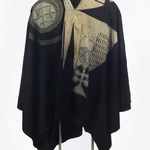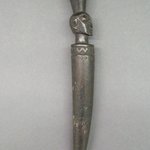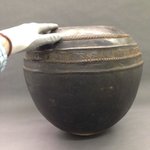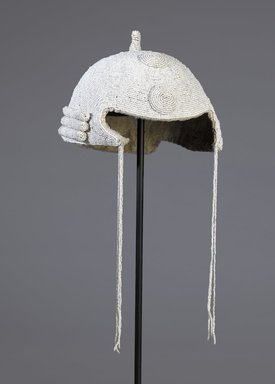
Beaded Crown (Oríkògbòfó)
Arts of Africa
ART OF INNOVATION
These three works speak to the highly inventive history of Yoruba art. Incorporating outside materials, they each reflect how both a colonial past and global exchange shaped shifting ideas about local identity.
Even this bead-embroidered crown, the ultimate symbol of Yoruba kingship, is the product of a complex global story. Although the Yoruba have a long history of glassmaking, the large, multicolored ade crown depicts figures wearing bowler hats and contains beads imported by the British in the late nineteenth century into what would soon become the Nigeria colony. The smaller beaded crown, known as an oríkògbòfó, is an evolution of the ade form, but it is modeled after the wig of a British barrister (lawyer), still worn in court today by members of the Nigerian judiciary.
Yinka Shonibare, a British artist of Yoruba and Nigerian descent, used Dutch wax-printed fabric to create Skipping Girl. This material—a commodity associated with Africa but actually created in Europe, based on Indonesian designs, and sold in West Africa—serves as a symbol of the web of economic and cultural interrelationships among Africa, Asia, and Europe. Shonibare exposes cultural "authenticity" as an illusion and evokes the layers of historical connections among global cultures.
These three works speak to the highly inventive history of Yoruba art. Incorporating outside materials, they each reflect how both a colonial past and global exchange shaped shifting ideas about local identity.
Even this bead-embroidered crown, the ultimate symbol of Yoruba kingship, is the product of a complex global story. Although the Yoruba have a long history of glassmaking, the large, multicolored ade crown depicts figures wearing bowler hats and contains beads imported by the British in the late nineteenth century into what would soon become the Nigeria colony. The smaller beaded crown, known as an oríkògbòfó, is an evolution of the ade form, but it is modeled after the wig of a British barrister (lawyer), still worn in court today by members of the Nigerian judiciary.
Yinka Shonibare, a British artist of Yoruba and Nigerian descent, used Dutch wax-printed fabric to create Skipping Girl. This material—a commodity associated with Africa but actually created in Europe, based on Indonesian designs, and sold in West Africa—serves as a symbol of the web of economic and cultural interrelationships among Africa, Asia, and Europe. Shonibare exposes cultural "authenticity" as an illusion and evokes the layers of historical connections among global cultures.
CULTURE
Yorùbá
MEDIUM
Beads, cloth, fiber
DATES
early 20th century
DIMENSIONS
16 15/16 x 7 7/8 in. (43 x 20 cm) (show scale)



COLLECTIONS
Arts of Africa
ACCESSION NUMBER
2012.74
CREDIT LINE
Gift of Jean C. and Raymond E. Britt Jr. Collection, by exchange
EXHIBITIONS
MUSEUM LOCATION
This item is not on view
CAPTION
Yorùbá. Beaded Crown (Oríkògbòfó), early 20th century. Beads, cloth, fiber, 16 15/16 x 7 7/8 in. (43 x 20 cm). Brooklyn Museum, Gift of Jean C. and Raymond E. Britt Jr. Collection, by exchange, 2012.74. Creative Commons-BY (Photo: Brooklyn Museum, 2012.74_PS9.jpg)
IMAGE
overall, 2012.74_PS9.jpg. Brooklyn Museum photograph, 2014
"CUR" at the beginning of an image file name means that the image was created by a curatorial staff member. These study images may be digital point-and-shoot photographs, when we don\'t yet have high-quality studio photography, or they may be scans of older negatives, slides, or photographic prints, providing historical documentation of the object.
RIGHTS STATEMENT
Creative Commons-BY
You may download and use Brooklyn Museum images of this three-dimensional work in accordance with a Creative Commons license. Fair use, as understood under the United States Copyright Act, may also apply.
Please include caption information from this page and credit the Brooklyn Museum. If you need a high resolution file, please fill out our online application form (charges apply).
For further information about copyright, we recommend resources at the United States Library of Congress, Cornell University, Copyright and Cultural Institutions: Guidelines for U.S. Libraries, Archives, and Museums, and Copyright Watch.
For more information about the Museum's rights project, including how rights types are assigned, please see our blog posts on copyright.
If you have any information regarding this work and rights to it, please contact copyright@brooklynmuseum.org.
RECORD COMPLETENESS
Not every record you will find here is complete. More information is available for some works than for others, and some entries have been updated more recently. Records are frequently reviewed and revised, and we welcome any additional information you might have.
